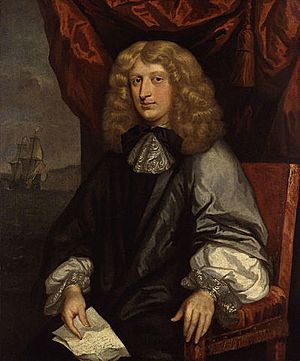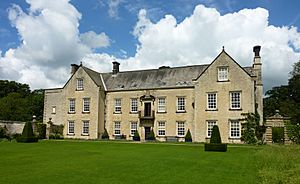Richard Graham, 1st Viscount Preston facts for kids
Quick facts for kids
The Viscount Preston
|
|
|---|---|

Portrait by Godfrey Kneller
|
|
| Lord President of the Council | |
| In office 1688–1689 |
|
| Preceded by | The Earl of Sunderland |
| Succeeded by | The Earl of Danby |
| Secretary of State for the Northern Department | |
| In office 1688–1689 |
|
| Preceded by | The Earl of Middleton |
| Succeeded by | The Earl of Nottingham |
| Personal details | |
| Born | 24 September 1648 Netherby, Cumberland |
| Died | 22 December 1695 (aged 47) |
| Alma mater | Christ Church, Oxford |
Richard Graham, 1st Viscount Preston (born September 24, 1648 – died December 22, 1695) was an English diplomat and politician. He served in the House of Commons, which is like today's Parliament, during two different periods between 1675 and 1689. Later in his life, he was involved in secret plans to bring back King James II to the throne. His reputation was affected when he shared information about these plans in exchange for a pardon.
Contents
Early Life and Education
Richard Graham was born at Netherby, in Cumberland, England, on September 24, 1648. He was the oldest son of Sir George Graham. His mother was Lady Mary Johnstone.
Richard went to Westminster School, a famous school in London. After that, he studied at Christ Church, Oxford, which is part of Oxford University, around 1664. He earned his Master of Arts degree in 1666.
Starting in Politics
Richard Graham began his political career on June 8, 1675. He was elected as a Member of Parliament (MP) for Cockermouth, a town in Cumberland. He continued to represent Cockermouth in Parliament for several years.
Even though he was a Protestant, he strongly supported James, Duke of York, who was Catholic, to become the next king. Richard Graham worked hard in Parliament to support James. Because of his efforts, he was given a special title in Scotland. He became Viscount Preston and Baron Graham of Eske in 1681. This title had actually been promised to his grandfather many years before.
In July 1681, Preston joined the Duke of York in Edinburgh, Scotland. He took his place in the Scottish Parliament and gave a speech about who should be the next king.
Working as a Diplomat
In May 1682, Richard Graham became an important diplomat. He was sent as an "envoy extraordinary" to the French court of King Louis XIV in France. His job was to discuss many important matters between England and France.
He dealt with issues concerning places like Orange and Luxembourg. He also talked about King Charles II of England possibly helping to make peace between France and Spain. Preston also reported on French actions in the Netherlands.
In August, he warned that there might be a secret plan in France to attack Ireland. He even hired spies to gather information. In September, he strongly protested to the French king about France taking control of the city of Orange.
In 1683, he was asked to tell French ministers that a certain Dr. Burnet was "a very ill man." Preston followed these orders. He also tried to find out more about the death of the Earl of Essex in the Tower of London. The Scottish towns thanked him for looking out for the rights of Scottish people in France.
Serving King James II
When James II became king, Preston returned to England. He settled in Soho Square in London. On April 2, 1685, he was elected as an MP for Cumberland.
He had hoped to become an English peer, but this did not happen. However, King James II trusted him greatly. Preston was put in charge of managing the House of Commons with another important person, Lord Middleton.
On October 21, he became a member of the Her Majesty's Most Honourable Privy Council, which was a group of trusted advisors to the king. A few days later, he became the chancellor for the queen-dowager, Catherine of Braganza. In 1687, he was made the Lord Lieutenant of Cumberland and Westmorland. These roles meant he was the king's main representative in those areas.
In late 1688, he became the northern Secretary and the Lord President of the Council. He was also one of five people chosen by the king to represent him in London when the king was away. Preston tried to tell King James that he needed to be more moderate in his actions, but his advice was not followed.
A Time of Trouble
After the Glorious Revolution, when King James II left the throne, Richard Graham still supported him. The French government, led by Louis XIV, gave him money for political reasons.
In 1689, King James II, who was now in France, gave Preston a new title: Baron of Esk in the English peerage. However, the English Parliament did not recognize this title.
In March 1689, it was reported that Preston was in northern England, planning ways to bring King James back. In May, he was arrested and sent to the Tower of London. He was later released on bail.
Preston continued to be involved in secret plans. He was still seen by his supporters as a brave and honorable person. The government, however, was watching him closely. In December 1690, a meeting of important supporters of King James was held. They decided that Preston should take their plans to King James in France.
Arrest and Pardon
Soon after midnight on January 1, 1691, Preston was caught hiding on a small boat trying to sail to France. He had important papers with him that were meant to be sunk if he was caught. These papers were seized.
Preston was sent to the Tower of London. On January 16, he was accused of a serious crime. He argued that as an English peer, the court did not have the right to judge him. But his argument was rejected. On January 17, he was found guilty and sentenced to death two days later. His property and title were taken by the crown.
For several months, his fate was uncertain. Lady Preston, his wife, asked the queen to spare his life. She was told he could save himself by telling everything he knew about the plans. After some time, he confessed what he knew. He named several people who were involved, including William Penn.
After several delays, the government believed he could tell even more. Finally, on May 1, he made another confession. This led to another delay in his execution, and soon after, he received a pardon. On June 13, he was set free. His property was kept by the crown as a promise that he would behave well. Later, in 1693, the queen gave £600 a year from his former property to Lady Preston and their children.
In August 1691, Preston was briefly sent back to prison for not giving evidence against some people, but he was soon released. After this, he was allowed to live quietly at Nunnington Hall in Yorkshire, a property he had inherited.
Translator of Boethius
Richard Graham spent the rest of his life working on a translation of a famous book called De Consolatione Philosophiae by Boethius. He had started this translation in 1680.
His translation was published after his death in 1695-1696. In the introduction, he wrote about his experiences. He suggested that his judges had been kinder to him than some of his friends, who had criticized him for giving in under pressure.
Death and Family
Richard Graham, 1st Viscount Preston, died at Nunnington Hall on December 22, 1695. He was buried in the church nearby.
He married Lady Anne Howard on August 2, 1670. They had a son named Edward (1679–1709), who became the second Viscount Preston after his father. They also had two daughters, Catherine (1677–1757) and Mary (died 1753). Catherine married William Widdrington. Mary never married. In 1739, Catherine and Mary inherited the Nunnington estate when their nephew, Charles, the third Viscount Preston, died without children.


